ENTS,
Jess Riddle and I spent three days on the Tennessee side of the
Smokies
exploring new areas and re-visiting known trees. Our primary
goal of the
trip was to climb and measure the Long Branch Hemlock, a huge
tree Jess and
his father found several years ago. The weather cooperated
beautifully and
we were accompanied by Morgan Simmons of the Knoxville News
Sentinel and
Kristine Johnson, Supervisory Forester for the Great Smoky
Mountains
National Park (GRSM).
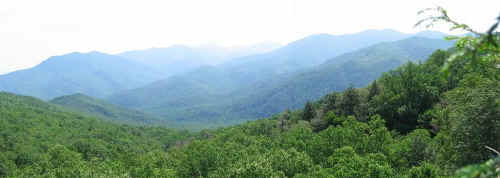
First, a summary of the climb. The Long Branch Hemlock (LBH) is
a huge tree
growing at about 3400' elevation on Long Branch, a tributary of
Porters
Creek in the Greenbrier section of GRSM. It grows in
selectively-cut but
still impressive rich northern hardwoods/ cove hardwoods
transition forest
with a delightfully open understory. Sugar maple is unusually
abundant with
a fair share of tuliptree, yellow buckeye, mountain silverbell,
yellow
birch, red maple, basswood and Fraser magnolia composing the
majority of the
other trees. Black cherry was harvested and stumps were found
over 11' in
girth. American chestnut debris was very common and logs were
strewn about
everywhere. Chestnut, black and scarlet oaks filled the gaps
lower down
while birches and maple were more common in the higher
elevations.

Long Branch hemlock whole trunk stitch
|
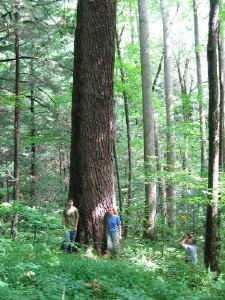
Long Branch hemlock base with Jess and Kris.
|
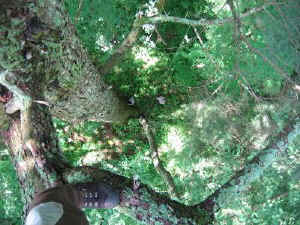
Long Branch hemlock at 95' with Kris at base.
|
|
At 16' in girth, the LBH is a massive tree which maintains a
hefty girth for
most of its 144' height. The top is very gnarly and stout, and
huge limbs
are common as this tree has no side competition. Many huge
broken limb stubs
indicate lots of storm exposure, and the crown is very complex
with ancient
bark even up near the top. I estimate the tree is around 350
years old, and
is truly one of the largest hemlocks I have ever climbed. We
took volume
(girth) measurements at inflection points to calculate
displacement volume.
The numbers are still being examined at this time, but it has no
less than
1300 ft3 of wood. The trunk of the LBH is larger than the
Yonaguska Hemlock
which at 1500 ft3 is the current volume record holder for the
species. I
think the LBH is larger but the numbers don't indicate so. Bob
Leverett and
I are reviewing the raw data for each tree and will re-examine
the
calculations soon. I suspect the Yonaguska tree is smaller, with
a
calculation error lurking in the spreadsheet.
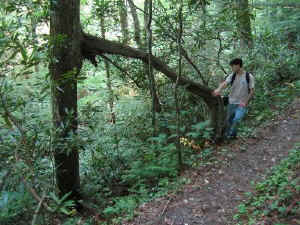 Stilt-rooted red maple.
Stilt-rooted red maple.
Jess and I began the tree measuring of our trip with, of all
trees, a redbud
(Cercis canadensis). Jess spotted the tree from the road near
the Metcalf
Bottoms Picnic Area. It was an astounding 3'4" in girth and
56.6' tall. Its
neighbor (a fused codominant stem) was 2'3" in girth and a
whopping 58'
tall- setting GRSM girth AND height records off the same base!
This tree was
spotted on our way to Lynn Camp Prong near the Tremont Institute
to
re-measure an American sycamore that I had not measured for 8
years. In 1997
I had lasered it to 152.7 feet tall which was a height record
for GRSM and
the East at the time (the new record is 162.2' in NC). On the
hike up we
estimated it should be close to 162' tall now if it continued to
grow with
no breakage. We established a midslope point, which on this tree
was a royal
pain since the uphill side of the tree was covered with fill
from a road
(which it had rooted into) and the base was in an abyss of
shoulder-high
stinging nettle on a crumbling bank in excess of 80% slope.
Finally a target
was set at 12' above grade and I went upslope to find a solid
shot. I found
a perfect location and found laser click-over for top and base
over 20
degrees above the target. Calculations determined the height to
be dead-on
162'! Girth was a puny 9'11" at 9 feet above midslope, but
a very imposing
tree given there was nothing close to its height for miles. A
few scattered
tulips approached 150' but for the most part, the trees were
very short.
We next went up a no longer maintained trail on nearby
Thunderhead Prong.
The heavily cut forest was absolutely unimpressive and short.
The area was
one of the last to be logged in GRSM and was utterly devastated.
Cables and
railroad trestles were common. We focused our attention on the
understory
species as nothing in the overstory was worth investigating. On
a tributary
named Sam's Creek we found a height record (for the Smokies)
alternate-leaf
dogwood (Cornus alternifolia) at 9" cbh X 28.8' tall and a
flowering dogwood
(Cornus florida) that reached an impressive 23" cbh X 49.2'
tall. Later,
along the road by Lynn Camp Prong we spotted a richer looking
forest with
some nice ironwood (Carpinus virginiana)
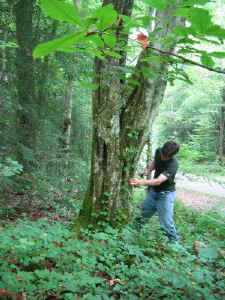 Cosby ironwood
Cosby ironwood
and paw-paw (Asimina
triloba). We
quickly confirmed two new park height
records for both species,
2'4" X 67.7' for ironwood and 15" X 47' for
paw-paw. Two other notable
ironwoods measured
2' X 56.1' and 3' X 61.5'.
Continuing our quest for "little giants" we returned
to the Twin Creeks area
on Grassy Branch Trail near Gatlinburg to measure a few trees I
had spotted
in the mid-1990's. One was a gorgeous, jet-black common
persimmon with an
impressive 5'5" girth. The height turned out to be 100.8
feet which is a new
"100 Footer Club" addition for the park, and a GRSM
big tree point champion
at ~174 points.
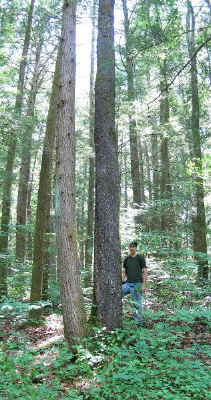 5.4 cbh X 100.8 foot tall common persimmon near Gatlinburg.
5.4 cbh X 100.8 foot tall common persimmon near Gatlinburg.
Nearby was a huge American beech 13' 7.5"
in girth with a
massive trunk.
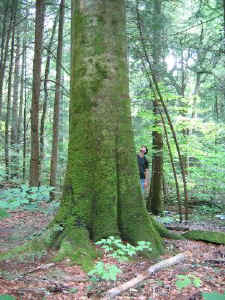
13.6 cbh American beech near Gatlinburg with Jess |
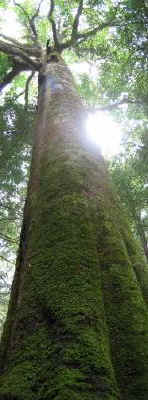
Giant American beech near Gatlinburg. |
While looking for some tall Virginia pines Jess
spotted a
moss-covered tree with a strange base. An exposed section of
bark indicated
it was a sugarberry (Celtis laevigata), and at 5'6" X 99.6'
is a TN height
record for the park. Further up stream we revisited a sourwood
by the Ogle
Cabin that was a whopper at 6' X 105.5'.
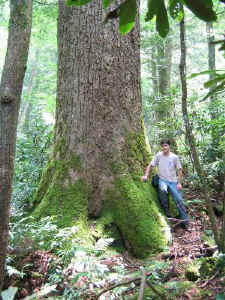 Tuliptree ~18 feet cbh on Boulevard Prong.
Tuliptree ~18 feet cbh on Boulevard Prong.
Continuing up through the Roaring Fork Motor Nature Trail we
stopped to
measure a huge Devil's-walkingstick (Aralia spinosa) that once
had a short
reign as the TN Champion before I found a larger one. It was
severely crown
damaged but still impressive at 29.5 inches around. It was once
close to 60'
tall. We did walk the Baskins Creek Trail but did not measure a
thing.
Nothing impressive (big tree-wise) was there- at least from the
west end to
the falls.
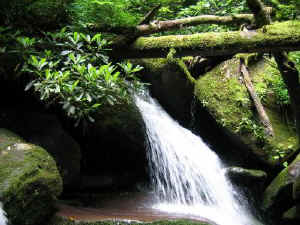 Falls on Boulevard Prong by giant cherry.
Falls on Boulevard Prong by giant cherry.
Near the exit of the motor nature trail we spotted a
green ash
that at 6'9" X 125.3' sets a new TN height record for GRSM-
if not the state
(?). Several nice shagbark hickories were scattered about but
nothing over
the mid-120's in height. Before calling it a day we measured a
flowering
dogwood Jess spotted in the Cosby Campground that was a
respectable 46.5'
tall despite having been partially severed by a poor pruning
cut. Jess also
showed me a massive ironwood with a girth of 5'8" and a
long spread of 74'
Yes, 74'!
The next day was the climb of the Long Branch Hemlock, after
which we
measured some fine red mulberries (Morus rubra) spotted on the
way to the
climb. To our surprise, two trees surpassed 70' tall! One was 3'
X 71.8' and
the other 3'6" X 73.4'. Another one was close to 70' at
3'4" X 69.2'. Close
to these trees was a gorgeous black walnut that just squeaked by
130' tall.
Several sweetgums exceeded 120', with one tree further
downstream at the
junction of False Gap Prong and Porters Creek an impressive
10'3" X ~115'.
Also in the area was a tall but declining butternut at 6' X
112.3'- a TN
height record.
 National Champion mountain silverbell 12.9 feet cbh X 117.4 feet tall.
National Champion mountain silverbell 12.9 feet cbh X 117.4 feet tall.
After the climb Jess and I went upslope to remeasure and photograph the
2004 National Champion mountain silverbell. We found it in excellent
condition (although hollow) and upon remeasuring it, found a "new" top that
was slightly higher. Its new measurements are 12'11" X 117.4' tall, up from
a previous height of 111'.
Our last day we decided to return to Boulevard Prong, a
tributary to Porters
Creek, that contains some very impressive trees. On the way up
we passed a
nice 6' X 101.6' sourwood and the former National Champion (but
probably
most legitimate) bitternut hickory.
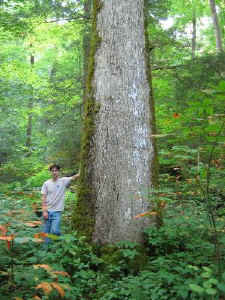 TN Champion bitternut hickory with Jess.
TN Champion bitternut hickory with Jess.
Through a series of
unfortunate
misidentifications and American Forest big tree coordinator
change-overs
this tree is now (once again) the National Champion "red
hickory" (Carya
glabra var. odorata). Despite a voucher specimen sent to AF and
solid field
characteristics that do not in any possible way indicate red
hickory this
tree continues to be renominated by the same man as the wrong
species (and
nearly 10 feet too tall as well!).
On Boulevard Prong we intended to find and remeasure four huge
trees; a
National Champion Allegheny serviceberry (Amelanchier laevis), a
National
Champion Devil's-walkingstick, a huge black cherry and giant
northern red
oak. We did not find the serviceberry or walking stick so we
continued up
stream to find the huge black cherry I had measured in 1996.
After tedious
rock-hopping, nettle, slippery rocks and fallen trees we finally
saw the
tree. It was further upstream than I thought but was still in
good
condition.
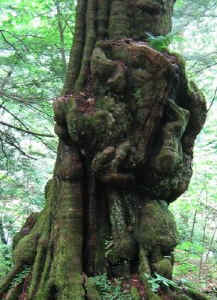
Giant black cherry burl detail.
|
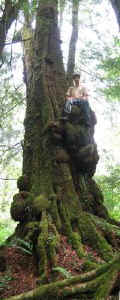
Giant black cherry view up trunk with Jess.
|
The tree is 17'11" in girth at 6' off the
ground, 24' at "true"
dbh and 31' in girth 1' off the ground. The crazy numbers are
due to extreme
"burlage" along the trunk, one of which looks like a
bear cub climbing the
tree. I'll let the photos do the talking on this one since it is
one of the
most indescribably gnarly trees I have ever seen! I roughed the
height from
below to ~119' which is a bit taller than I had it before
(~111'). It is
growing in an extremely rugged area and a good sin+sin laser
height was
neither reasonable nor justified.
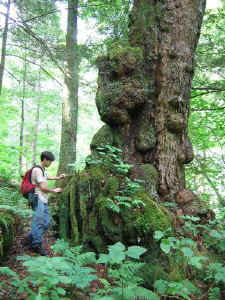
Giant black cherry with Jess.
|
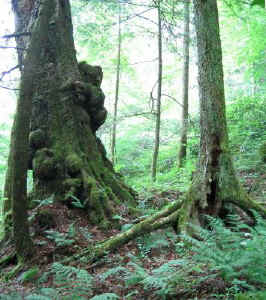
Giant cherry and yellow birch with ...bear cub.
|
From the huge cherry we went across the creek to the northwest
to search for
the huge northern red oak I spotted in 1996. Traversing cove
after cove of
similar forest we finally saw the immense bulk of trunk in a
small draw
below us. I stayed up high to get a good height measurement
while Jess
dropped down for the girth and base spotter position. I hit a
solid 141.8'
tall arising from a massive 18'4.5" cbh trunk. This tree is
really massive
and is likely close to tied with the Double Gap tree (NC) for
the largest
northern red oak in the eastern US based on volume. Try to spot
Jess in the
photo taken from upslope!
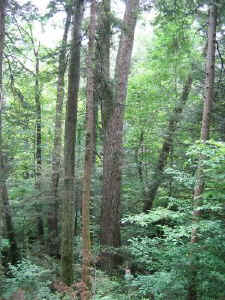
Red oak 18.4 feet cbh X 141.8'. |
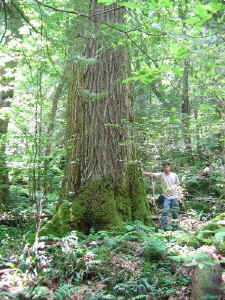
Red oak 18.4 feet girth. |
Our drive back was completed with a stop at a grove of big-tooth
aspen that
I have been driving by for over 12 years! I had just never
stopped to see
them up close. So finally they were measured! Most of the small
grove was on
a road bank but one seed had sprouted in a small ravine which
forced it to
grow tall to maintain canopy position. This tree surprised us
both with a
girth of 3'10.5" X 91.6'! WOW! What gorgeous trees.
More to come on the continuing saga of hemlock volumes.
Will and Jess
July 21-23, 2005
|